Available with Standard or Advanced license.
A parcel in the parcel fabric is composed of point features, line features, and polygon features. The parcel polygon is defined by a sequence of individual lines, which form a closed loop to define a polygon. Each line has a from and a to point that are also the parcel corner points. Points are common between connecting lines and adjacent parcels. Parcel points can be assigned line points and control points. A parcel is always associated with one plan (record of survey).
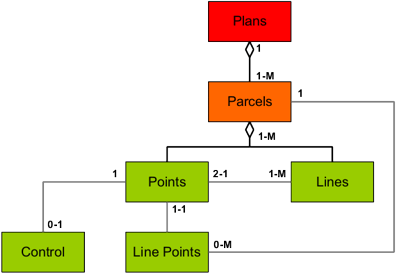
Parcel features
A parcel in the parcel fabric has the following features:
- Points
- Lines
- Polygons
Parcel polygons
Parcel polygons are defined by a closed sequence of related lines. Parcel polygons store information about the parcel, such as the parcel identification number and the parcel area. Parcel polygons can be multipart, singlepart, or donut/island parcels. In the geodatabase, parcel polygons are related to their lines:
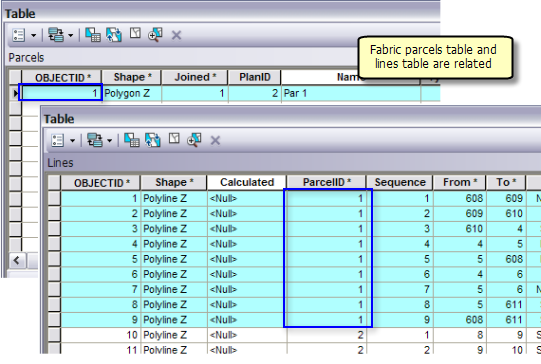
Parcel lines
Parcel lines are the boundaries of parcels and form the parcel boundary network. Parcel lines are also connection lines and radial lines. Parcel lines store COGO dimensions, which should ideally or eventually match recorded dimensions on the record of survey or plan.
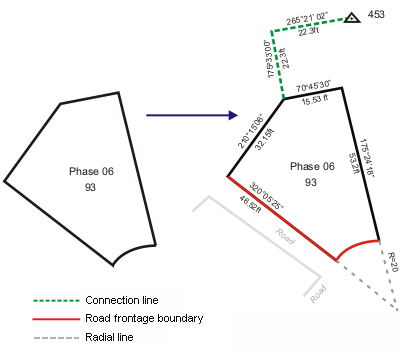
Each parcel line is a two-point line, from one point to the other. These points are also the corner points of a parcel. Parcel lines are related to parcel points.
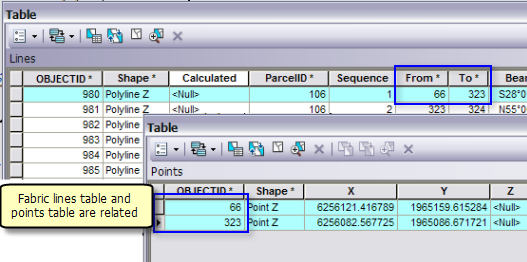
Parcel lines use the following line categories:
- Boundary
Represents the boundary of a parcel or unclosed parcel.
- Dependent
Used for lines that are dependent on parcel boundary lines, for example, easement lines. Dependent lines do not define the boundaries of parcels; that is, a closed loop of dependent lines will not create a parcel.
- Precise Connection
- Used for lines that connect a parcel point to closely located control point. The line effectively places the control point on top of the parcel point.
- Connection
Used for lines that connect parcel points across right-of-ways and connect parcel points to control points.
- Radial
Used for lines that radiate out from the end points of curved lines to their center points.
- Road Frontage
Used for lines that lie adjacent to roads or right-of-ways.
- Origin Connection
Used for lines that connect a point of beginning to the starting point of a parcel. The point of beginning could be a control point.
- Part Connector
Used for lines that connect the parts and/or rings of a multipart or donut parcel.
Parcel points
Parcel points store x,y,z coordinates, which are initially generated when parcel data is either migrated or joined to the parcel fabric. Parcel points represent parcel corners, curve center points and end points of connection lines. There are points at the endpoints of every line in the parcel fabric. Points are common between shared boundaries. One point represents a single location and points do not overlap.
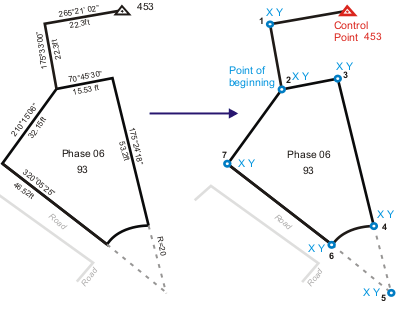
Line points
A parcel point can also be a line point in the parcel fabric. A line point is assigned to a parcel point when it lies on the boundary of an adjacent parcel, but does not split the boundary. Line points allow parcel points to be constrained to lie on boundary lines without splitting or cracking the line into multiple lines. This is important for preserving the recorded information. A parcel boundary should be represented with a single bearing and distance and not with separate bearings and distances if an adjacent parcel corner point is lying on or splitting the boundary line.
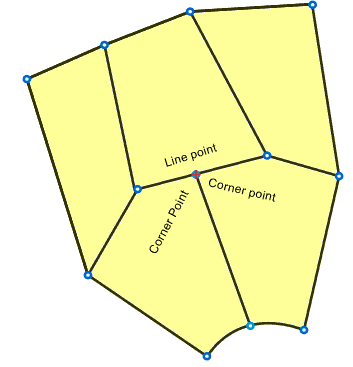
Control points
Control points define accurate, surveyed x,y,z coordinates for physical features on the surface of the earth.
Control points are added to the parcel fabric so that parcels can be adjusted to the control network in a parcel fabric, least-squares adjustment. The result is parcels that are accurately georeferenced on the surface of the earth. While parcel dimensions accurately define parcel boundaries in relation to each other, control points, when used in a parcel fabric adjustment, accurately define spatial locations for parcel corner points.
Control points are defined by x,y coordinates on a projected grid (a 2-D plane) and, separately, by a z-value representing height above sea-level. Control points in a parcel fabric do not represent coordinates in a three-dimensional Cartesian coordinate system that defines an actual ground position. The distance computed between two control points in the parcel fabric (using x and y only) is a grid distance.
Plans
The parcel fabric provides a way to enter and organize parcel data based on the manner in which it was originally recorded (plans or record of survey). Parcels can be created in plans, loaded into plans, or appended into plans from cadastral XML files. To create a new parcel in a new plan, create the plan, right-click the plan in the Plan Directory dialog box, and click New Parcel.
Parcels are grouped in the parcel fabric by their associated plan, and the plan properties are maintained in a separate, related table. If you do not want to maintain plans in your parcel fabric, you can use the default <map> plan.
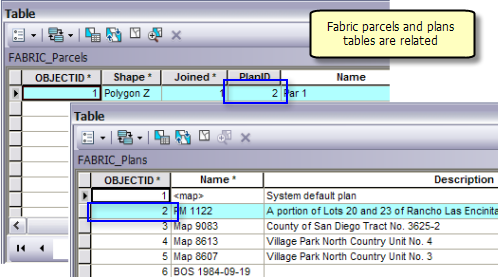
Parcel fabric relationships
The following list summarizes the relationships between parcel features and tables:
- A parcel polygon is related to its lines
- A parcel line has two, related endpoints.
- A parcel line is related to only one parcel, resulting in two lines representing adjacent parcel boundaries.
- A parcel point can be related to one control point.
- A parcel point is related to one or more lines.
- A line point is related to one or more parcel polygons.
- A line point is related to one parcel line.
- A parcel point can be related to one line point.
- A parcel polygon can have many line points.
- A parcel polygon is related to one plan.
- A parcel point can have one or more adjustment vectors (for example, from a parcel fabric least-squares adjustment).
- A parcel polygon has one accuracy category (used by the parcel fabric least-squares adjustment).
- A parcel line has one accuracy category (used by the parcel fabric least-squares adjustment).